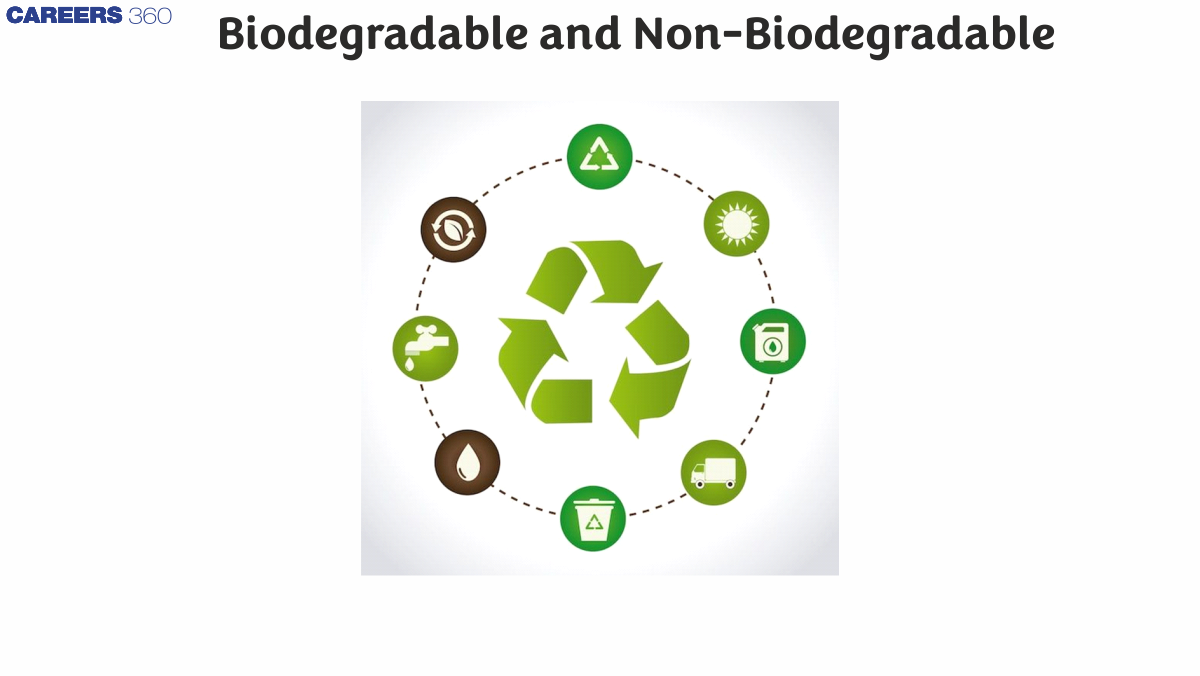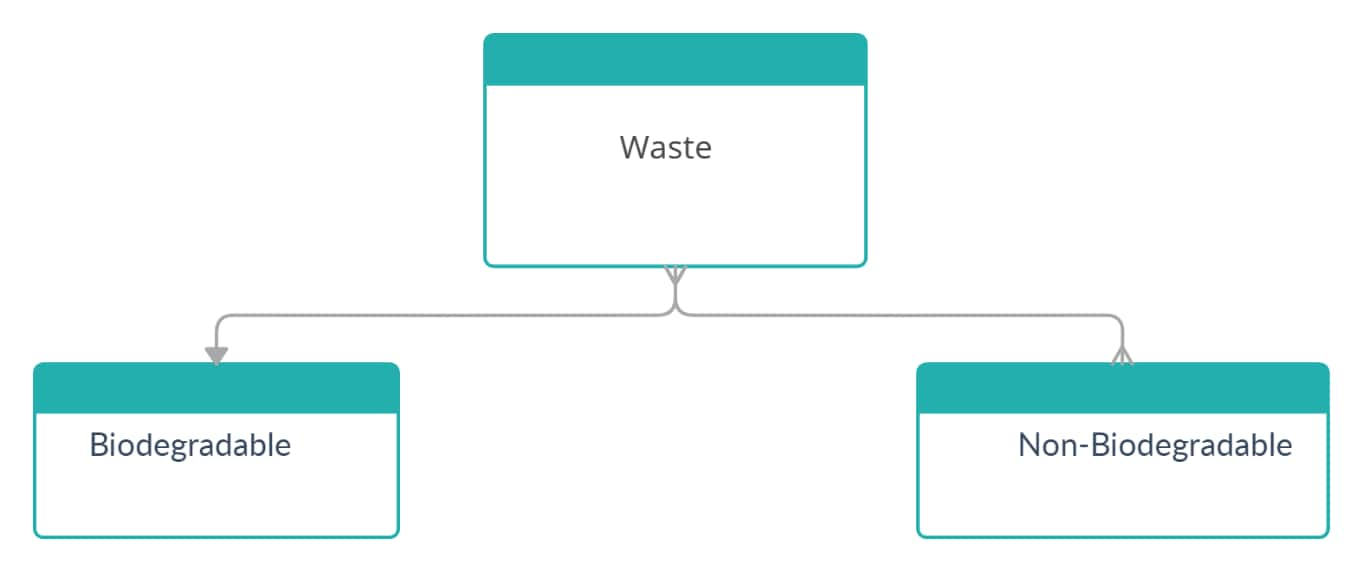Biodegradable and Non Biodegradable - Definition, Examples, Difference, FAQs
Every day, we produce a lot of waste and throw away or discard the waste in our surroundings. This category includes edible peels and fruits, empty cartons, tea leaves, old clothing and shoes, and many other disposable items. Biological processes can break down materials such as paper, vegetable, and fruit peels by the action of bacteria or other decomposers. Such materials are called as biodegradable because those can be broken down effortlessly by bacteria. On the other hand, there are materials which cannot be decomposed by biological processes called as non-biodegradable materials. Such substances includes plastics, metallic cans, and pesticides.
NEET 2025: Mock Test Series | Syllabus | High Scoring Topics | PYQs
JEE Main: Study Materials | High Scoring Topics | Preparation Guide
JEE Main: Syllabus | Sample Papers | Mock Tests | PYQs
- What is the Meaning of Biodegradable?
- What is biodegradable waste?
- What does non-biodegradable mean?
- Difference Between Biodegradable and Non- biodegradable:
- Effects of Waste Material on Environment:
- Treatment:


What is the Meaning of Biodegradable?
Microorganisms (such as bacteria and fungi), temperature, sunlight, and oxygen are all able to degrade waste materials in the natural environment. Biodegradable waste include kitchen wastes, food wastes, biodegradable polymers among others. It is the work of microorganisms and other abiotic elements to break down complex organic substances into simple organic matters that are subsequently consumed by the soil. This entire process is natural and can be slow or fast. Therefore, biodegradable waste have very low risk and low impact on the environment.
Also read :
What is biodegradable waste?
An organic waste that can be decomposed by other living organisms, including plants and animals, is termed biodegradable waste. Usually, organic materials are present in municipal solid waste such as green waste, food waste, paper waste, and biodegradable plastic.
What does non-biodegradable mean?
A non-biodegradable material is any material that is incapable of being broken down by natural organisms. Non-biodegradable wastes cannot easily be gotten rid of, unlike biodegradable wastes. Non-biodegradable wastes are those that are incapable of decomposition or degradation by natural agents. Despite thousands of years without degradation or breakdown, they remain on earth. They are also more dangerous, so the threat they cause is also much broader.
Plastics can be spotted in almost every industry to provide an example of biodegradable and non- biodegradable. Better quality plastics can be applied to give these plastics a long-term outcome. It made them more resistant to temperature changes and harder after being used. Metals, cans, metal products, detergents and chemicals for agricultural and industrial uses are also common causes.
Non-biodegradable waste materials are not eco-friendly and should be removed or substituted. Science has contributed many innovative ideas with regards to the development of alternatives, such as biodegradable plastics. The Companies combined biodegradable material with plastic to create a material that degrades rapidly. It is a rather costly procedure. There are biodegradable wastes that can be recycled and reused again, and there are non-biodegradable wastes that are not recyclable and further leads to increase in biological oxygen demand in the water bodies.
Related Topics |
Difference Between Biodegradable and Non- biodegradable:
S.NO. | Biodegradable | Non-Biodegradable |
1. | There is a rapid degradation process for biodegradable waste, | Degradation process in Nonbiodegradable waste is slow |
2. | Biodegradable waste is decomposed by microorganisms. | Non-biodegradable waste cannot decay. |
3. | Biodegradable waste is not collected but decomposes in a short time | Non-biodegradable waste is usually collected |
4. | Biodegradable waste enters biogeochemical cycles and can be recycled promptly | Non-Biodegradable waste cannot enter those cycles, which are slower and are more harmful to the environment. |
5. | Making compost and biogas is possible with biodegradable waste | It is possible to recycle non-biodegradable waste, but the process is expensive |
Effects of Waste Material on Environment:
Around the world, waste quantities are commonly grown in all countries. There are billions of tons of waste produced each year. Our homes, businesses, and industry generate waste and dispose of it in large amounts, which creates a vast environmental problem. Large-scale pollution of both land and water occurs by agriculture, municipal & industrial solid waste, and biomass deposits on biodegradable and non- biodegradable waste.
Waste production damages materials and energy and raises environmental costs for society due to the collection, treatment, and disposal of waste. Due to greenhouse gas emissions (methane and carbon dioxide) and transboundary movements of organic micropollutants (dioxins and furans) and heavy metals, landfills and incinerators have a significant impact, Humans have struggled with waste since the dawn of time.
They found that waste is a source of illnesses, diseases, and infections, so they dumped their waste, which was entirely biological, all the way out to sea. Municipal dumps were first conceived in 500 BC outside ancient Greece, where regulations required waste to be dumped for at least a mile outside the city limits. Before the industrial revolution, most wastes Was organic, meaning it could decompose or degrade naturally. Due to industrialization, urbanization, and the growth of society, the amount of waste increased significantly.
Treatment:
A non-biodegradable or one which is biodegradable can be harmful to humans and the environment. So, it is necessary to treat wastes correctly. To reduce waste, we have to work together as a society. We all have a role to play. Each of us can take simple steps to combat the three "Rs"- Recycle, Reuse, and Reduce. As well as saving energy, this can also protect other resources. Another step is to separate biodegradable and non- biodegradable garbage at home and dispose of it separately.
Also check-
Frequently Asked Questions (FAQs)
A biodegradable material or object can be decomposed by organisms found in nature, such as bacteria.
Non-biodegradables are materials or substances that cannot fully decompose through biological processes. Plastic and artificial waste are also among the non-biodegradable materials.
In the process of accumulation, biodegradable and non- biodegradable waste poses a significant threat to the environment. Among the adverse effects of non-biodegradable waste are clogged drains, destruction and contamination of water bodies, soil erosion, Climate change, Death of cattle because of ingestion of the plastics, also nutrition deficient crops, and ecological imbalance.
Also Read
02 Jul'25 07:48 PM
02 Jul'25 07:48 PM
02 Jul'25 07:48 PM
02 Jul'25 06:35 PM
02 Jul'25 05:25 PM
02 Jul'25 05:25 PM
02 Jul'25 05:25 PM
02 Jul'25 05:06 PM
02 Jul'25 04:57 PM

